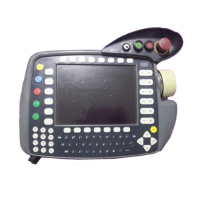7Resolver--to--DigitalConverter(RDC)
61 of 70
Hardware R2.2.8 1 1.98.02 en
7Resolver--to--DigitalConverter(RDC)
7.1 Description of the RDC
The RDC card with built--in DSP (Digital Signal Processor) is located in a housing at the base
of the robot and performs the following functions:
-- Generation of all necessary operating voltages from the 27V supply;
-- Res o lve r pow e r s upply f o r 8 a x es ;
-- Isolated power supply of 8 temperature sensors (KT Y 84) in the motor windings;
-- R/D conversion for up to 8 axes (approx. 3 x 4096 increments/motor revolution)
-- A/D conversion for 8 temperature sensors (12--bit resolution);
-- Evaluation of 2 EMT channels (1 EMT);
-- Res o lve r ope n --c irc uit m o nit or i ng;
-- Mot or t e mp e rat ur e m o nit or i ng;
-- Communication with the DSEAT via an RS422 serial interface.
The RDC also has an EEPROM that stores the following data even after the controller is swit-
ched off:
-- Operating hour counter (counts in minutes when the brakes are opened; can be
displayed with $ROBRUNTIME);
-- Absolute position (important for maintaining the mastering), in increments;
-- Res o lve r pos it ion ( t h i s v a lue is c om par e d t o t he a c t ual r e sol v er posi t i o n on power --
up -- tolerance 6 increments), in increments;
-- Calibration data (offset, symmetry).
Moreover, this EEPROM also contains a write--protected area with the boot program for the
processor.
The cable cores of the 6 robot axes are routed into the housing via a special molding and
are plugged directly to the circuit board.
The cables of the 2 external axes are passed through a screwed gland and connected to the
RDC.
Advantages of this independent module:
-- The DSEAT can be smaller and can therefore be designed as a PC module;
-- No functions requiring a +/--12V supply voltage are located on the DSEAT: this
configuration would cause problems, because the PC power supply unit cannot
supply the necessary voltage, especially in the case of --12V;
-- The cables for the resolvers and motor temperature do not have to be routed to
the DSEAT:
shorter shielded cables (only in the robot),
no problems of space requirement, stability and cable routing on the DSEAT;
-- The encoder cable contains 6 conductor pairs instead of 20 in the old system:
thinner, m ore f lexible and cheaper cable,
instead of a Harting connector, another (smaller, cheaper) connector can be used.

